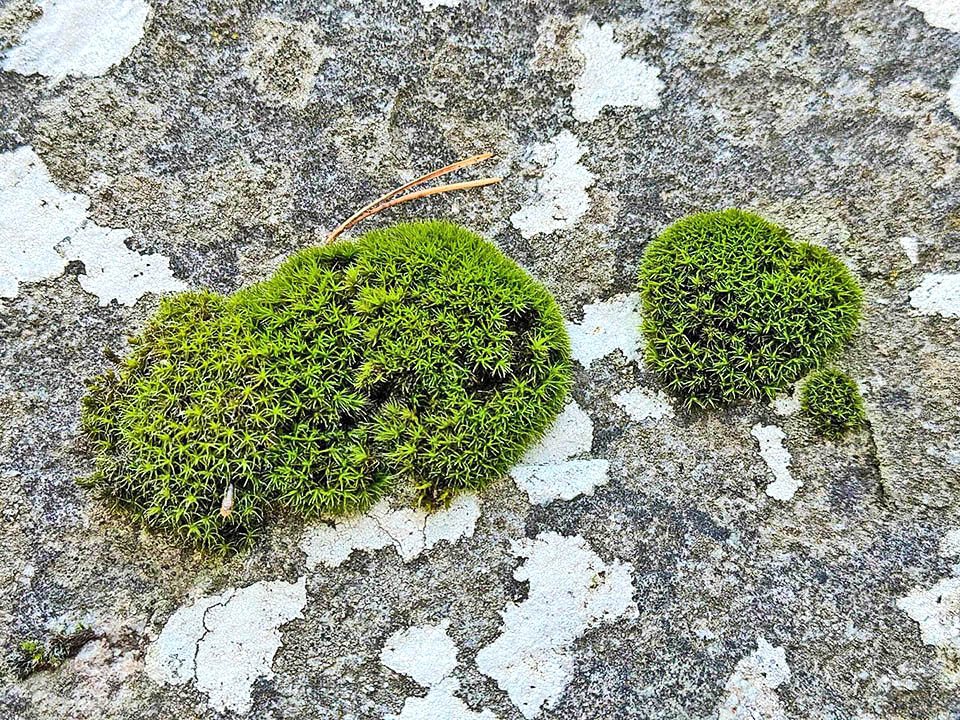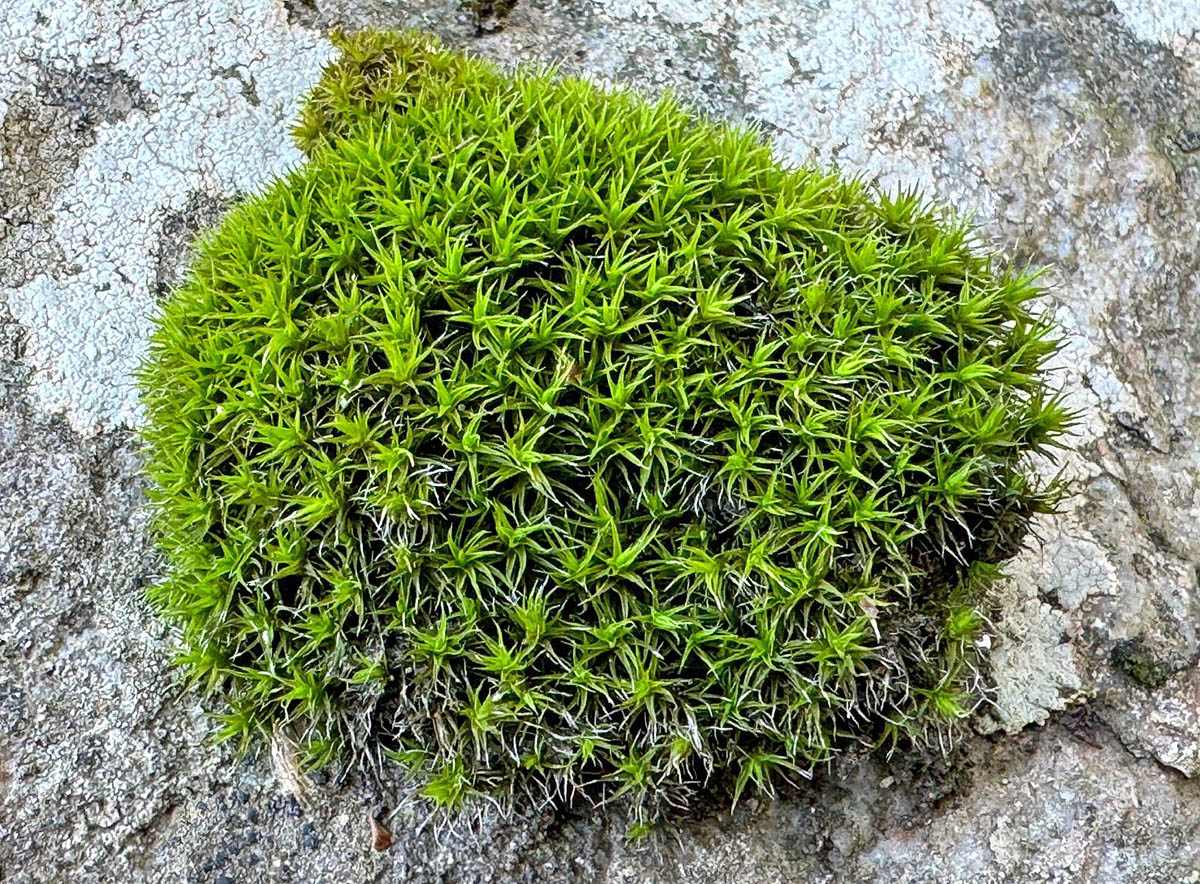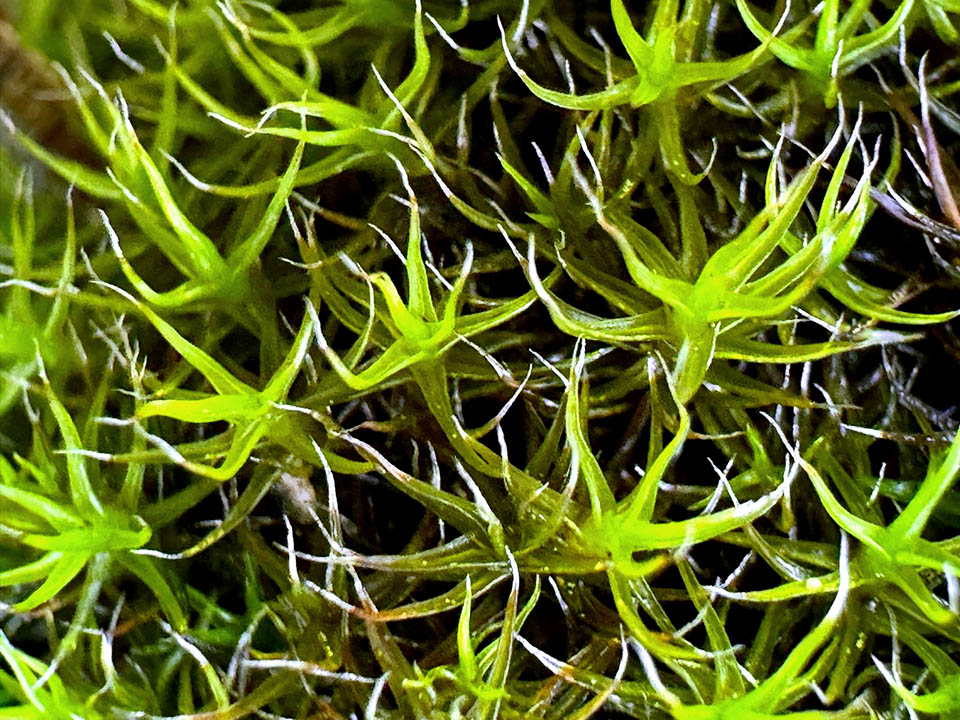Family : Grimmiaceae

Text © Prof. Pietro Pavone

English translation by Mario Beltramini

Grimmia lisae is a common thermophilic moss, perennial, terrestrial-saxicolous preferring the subtropical coastal zones with Mediterranean-Atlantic range © G. Mazza
Grimmia lisae De Not. (1837) is a moss belonging to the family Grimmiaceae (Bryophyta) that includes 369 species distributed in 10 genera (Bucklandiella, Codriophorus, Coscinodon, Dilutineuron, Frisvollia, Grimmia, Leucoperichaetium, Niphotrichum, Racomitrium, Schistidium); recently has been added the genus Tricarinella (2018) that includes one fossil species, Tricarinella crassiphylla, dating back to Lower Cretaceous (ca. 136 million years ago).
The genus Grimmia was called so by Jakob Fredrich Ehrhart (1742-1795) in honour of Johann Friedrich Carl Grimm (1737-1821), physician and botanist of Gotha, Germany. The specific epithet lisae has been given by the Author in honour of Domenico Lisa (1801-1867), gardener of the Turin Botanical Garden who discovered this species among the rocks of the hilly area of Turin territory.
Commonly this species is in Italian called Grimmia di Lisa, In English, Lisa’s Grimmia, Gravel Grimmia.
Grimmia lisae is a thermophilic species, terrestrial, saxicolous, relatively common with a preference for the coastal subtropical zones. It is generally confined to the Northern Hemisphere with caulids a Mediterranean-Atlantic range. Particularly, it is found in temperate Europe, in the Mediterranean islands, in central Europe (Germany and Switzerland), quite rarely further east (Hungary, and European Turkey). It is also present in Macaronesia, northern Africa, south-western Asia, western coast of North America from Vancouver (Canada), south up to Mexico and Hawaii. Usually it lives on acidic to basic dry rocks from 100 to 1000 metres of altitude.
Grimmia lisae forms dense small cushions (pulvini), often of dark green colour in surface, brownish or blackish in the lower part. The stems (caulids) are decumbent, sparsely ramifie, 2-3(4) cm tall, with a poor distinct central cord. The leaves (phyllids) are strictly appressed when dry, erect and curved if humid, 3-5 mm long, broadly lanceolate, keeled above , with a finely sharp apex with hyaline, denticulate hair, up to 1 mm long in the upper leaves. The lamina is unilayered, bilayered at the apex, and at times also in the upper half. The leaf margins are curved on one or on both sides. The nervation, ending at the apex, is prominent on the back; in section it displays a group of steroids with mechanical function, with thickened walls. The lower cells are rectangular, hyaline, with sometimes thickened, smooth, walls, the median ones briefly rectangular, more or less sinuous; the upper ones are small, square-rounded, translucent but with thickened but not sinuous walls.

It forms dense, small pulvini intense green in surface, brownish or blackish in the lower part. The caulids are poorly ramified, 2-4 cm tall © Giuseppe Mazza
The vegetative reproduction is absent.
It is an acrocarpous moss due to the apical position of the sporogonium (the structure that produces the spores) located at the extremity of the stem (caulidium). The sexual reproduction occurs on separate individuals (dioecious species) and after the fecundation of the gametes the diploid generation takes place (2n) developing on the female gametophyte (haploid individual). The sporophyte is formed by a foot, a seta and a capsule where, in meiosis, get form the haploid spores.
The seta is curved, yellowish, 0,3-0,5 cm long that extends in an ovoidal, protruding capsule, 1,3-1,5 mm long, weakly ribbed, brownish, weakly striped, with mitriform calyptra, enclosing. partially the operculum. The operculum has a rostrum, and under it stands the peristome with lanceolate teeth, fissured in 2-3 filaments, orange or reddish, densely papillose. The spores are brown-yellowish, minutely papillose and are 12-15 μm long.
This moss, with its luxuriant green carpets, has an extraordinary visual impact and consequently is often utilized in the rocky gardens to cover the ground. As a matter of fact, it is quite fit for being grown in the partially or totally shaded areas of the gardens. It loves the humidity but the excessive watering should be avoided as this might create yellowed carpets whilst the poor watering causes wilting.
It is a perennial plant, slow-growing, and the full maturity occurs after about 2-3 years. It is able to stabilize the substratum and to prevent erosion, and this renders it suitable for the sloping gardens.
Grimmia lisae prospers in the well drained substrata but poorly tolerates the nutrients, therefore the fertilization needs are minimal. An excessive fertilization may cause harm instead of helping it. Dead or damaged carpets must be removed also to encourage new growth. Also an occasional cleaning is useful.
This practice helps prevent debris accumulation, as these may host parasites and diseases.

The 3-5 mm long leaves appear strictly appressed when dry, erect and curved if humid. The antioxidant medicinal virtues of the plant have always been known © G. Mazza
Grimmia lisae spreads by division of the tuft or by spores. The separation of the plant’s leaflets is to be done in early spring or in autumn. The spores that require a careful collection are sprinkled on an acidic soil kept constantly humid to promote the germination.
In the traditional medicine Grimmia lisae is utilized as an antioxidant due to the presence of phenolic compounds.
According to the IUCN Red List in Europe, Grimmia lisae is not cause of concern and therefore it is inserted into the category “Least Concern, LC”.
Synonyms
Dryptodon lisae (De Not.) Loeske; Dryptodon sardous (De Not. ex Müll.Hal.) Loeske; Grimmia ancistrodes Durieu & Mont.; Grimmia azorica Renauld & Cardot; Grimmia californica Sull.; Grimmia canadensis Kindb.; Grimmia flettii (Holz.) Cardot; Grimmia hartmanii f. retracta (Stirt.) Loeske; Grimmia hartmanii subsp. retracta (Stirt.) Dixon; Grimmia hartmanii var. retracta (Stirt.) Podp.; Grimmia lisae subsp. sardoa (De Not. ex Müll.Hal.) Kindb.; Grimmia muehlenbeckii var. lisae (De Not.) Bott.; Grimmia muehlenbeckii var. sardoa (De Not. ex Müll.Hal.) M.Fleisch.; Grimmia retracta Stirt.; Grimmia retracta var. submutica Stirt.; Grimmia sardoa De Not. ex Müll.Hal.; Grimmia sardoa var. robusta M.Fleisch. & Warnst.; Grimmia subsquarrosa var. edinensis Braithw.; Grimmia torquata var. flettii (Holz.) Vaar.; Grimmia trichophylla f. propagulifera H.Winter; Grimmia trichophylla subsp. azorica (Renauld & Cardot) Luisier; Grimmia trichophylla subsp. lisae (De Not.) Boulay; Grimmia trichophylla subsp. sardoa (De Not. ex Müll.Hal.) Bott.; Grimmia trichophylla var. brachycarpa De Not.; Grimmia trichophylla var. edinensis (Braithw.) Dixon; Grimmia trichophylla var. lisae (De Not.) Bott.; Grimmia trichophylla var. sardoa (De Not. ex Müll.Hal.) Boulay; Grimmia trichophylla var. subincurva H.Winter; Racomitrium flettii Holz.
